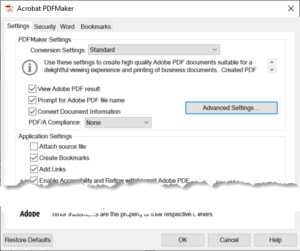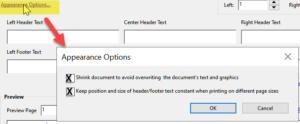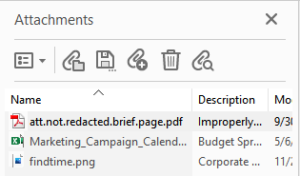Advanced Acrobat Tips
 Adobe Acrobat is the de facto standard for law firms. It is used for forms, esignatures, converting Word processing documents to PDF, reviewing discovery files, sharing information, combining multiple documents, redaction, Bates stamping and much more. Tools that let lawyers create and manipulate PDF documents are essential to the paperless office and are the standard for efiling. The current supported versions of Acrobat are DC (pro and standard) and Acrobat 2017. Here are some advanced features to make the most of your PDF documents.
Adobe Acrobat is the de facto standard for law firms. It is used for forms, esignatures, converting Word processing documents to PDF, reviewing discovery files, sharing information, combining multiple documents, redaction, Bates stamping and much more. Tools that let lawyers create and manipulate PDF documents are essential to the paperless office and are the standard for efiling. The current supported versions of Acrobat are DC (pro and standard) and Acrobat 2017. Here are some advanced features to make the most of your PDF documents.
Creating Hyperlinks
If you are converting a Word document to PDF with Adobe Acrobat, any hyperlinks to email addresses or websites in the document will automatically convert to links in the resulting PDF (with some caveats). If you need to add a hyperlink after the document is saved to PDF you can add it by selecting the text that you want to have hyperlinked, right clicking and choosing “Create Link”. In addition to linking to a website, you can also go to a page view or open a file. Want to make it easy for a viewer to dial a number from a PDF if they are reading it on a smart phone? Select the phone number in the PDF document and right click. After choosing “Create Links” and “open a webpage” as the link action you type the URL for the link as tel:###-###-#### . To get even more options once you have created the link go back and right click to edit and in the editing dialog box click on the Actions tab to see additional functions like playing a video or opening a file.
Bookmarks from Headings
 If you are creating a PDF from a MS Word document that was created using Styles/Headers, Acrobat will automatically create bookmarks from those styles. In the conversion settings make sure that the “Create Bookmarks” under Application Settings is checked in the Preferences of the Acrobat toolbar in MS Word. When you open the resulting PDF document in Acrobat click on the Bookmarks symbol in the left side of the document to review and clean up the bookmarks if necessary.
If you are creating a PDF from a MS Word document that was created using Styles/Headers, Acrobat will automatically create bookmarks from those styles. In the conversion settings make sure that the “Create Bookmarks” under Application Settings is checked in the Preferences of the Acrobat toolbar in MS Word. When you open the resulting PDF document in Acrobat click on the Bookmarks symbol in the left side of the document to review and clean up the bookmarks if necessary.
If you want to make sure your readers know the bookmarks are available, you can change the opening view of the document, so the bookmark panel automatically opens. Once you have finalized your bookmarks go to File – Properties and click in the tab called “Initial View”. Under Layout and Magnification choose “Bookmarks Panel and Page” in the Navigation Tab drop down menu. However, many people are opening PDFs on their native smartphone apps and in their browser so these bookmarks may not appear.
Correcting OCR
If you scan a file to PDF the resulting file is an image and is not searchable or editable until you run Optical Character Recognition on the document. In most cases your firm has likely set up a workflow to automatically scan with OCR. However, OCR is imperfect. It looks for character shapes in the image that match an alphabet in the OCR engine and tries to identify what letter the shape is. In the PDF you will still see the exact image of the file you scanned, but once you run OCR there is a layer underneath of text based on the OCR’s attempt at identifying letters and numbers. Most of the time OCR is good enough for a quick text search. However, if the OCR needs to be more accurate you can correct recognized text.
In a PDF document in the “Find Tools” search type in “OCR”. Run “Recognize Text” over the scanned document first (even if it has been run before). You can also run OCR on multiple documents at a time. After this is complete click on the “Recognize Text” arrow in the Scan & OCR toolbar to see the option for “Correct Recognized Text”. This will start a workflow wherein Acrobat shows you OCR suspects, or words that may not have been accurately matched. You can just click “Accept” if the word is correct or you can edit it. This can be time consuming, but for search accuracy may be necessary. You can run OCR and OCR corrections over multiple documents at once.
Advanced Search
To search through a document or a set of documents in Acrobat first you must find the Advanced Search function. The magnifying glass icon in Acrobat DC in the horizontal toolbar is for find and replace. In the right navigation column “search tools” is used to search for functions. To search across documents go to Edit in the top horizontal menu (next to File) and click “Advanced Search”. You can search for words in a single document or across a folder full of documents. At the bottom of the Search dialog box click “show more options” and you will see search refinements such as making your search case sensitive, proximity searching, and including attachments. If you are searching across multiple documents, you can add additional criteria to refine your search by metadata such as date created and author.
Adding Page and Bates Numbers Without Overwriting Text
 You probably already know you can insert footers with page numbers and Bates stamp documents. However, if the PDF you wish to add these elements to is the result from combining multiple documents you may find that your page numbers are difficult or impossible to read because of the placement of page numbers in the original documents. To solve this problem go to the Edit PDF tools and from the toolbar select “Header and Footer” then click “Add”. In the resulting dialog box choose where you want the page numbers (right, left, center, etc.) and click inside the box. Then click “Insert page number”. You can add additional text, such as “Combined files for Reach Estate, page <<1>>”, to make a distinction from existing pagination in the document. Then, in the dialog box, on the upper left you will see blue text that reads, “Appearance Options…”. Click on this and check the boxes for “Shrink document to avoid overwriting the document’s text and graphics” and “keep position and size of header/footer text constant when printing on different page sizes”. Then click “OK”. This will keep your page numbers for the new document distinct from the page numbers already in the document. You can apply Bates numbers in the same way and apply them to multiple documents at once.
You probably already know you can insert footers with page numbers and Bates stamp documents. However, if the PDF you wish to add these elements to is the result from combining multiple documents you may find that your page numbers are difficult or impossible to read because of the placement of page numbers in the original documents. To solve this problem go to the Edit PDF tools and from the toolbar select “Header and Footer” then click “Add”. In the resulting dialog box choose where you want the page numbers (right, left, center, etc.) and click inside the box. Then click “Insert page number”. You can add additional text, such as “Combined files for Reach Estate, page <<1>>”, to make a distinction from existing pagination in the document. Then, in the dialog box, on the upper left you will see blue text that reads, “Appearance Options…”. Click on this and check the boxes for “Shrink document to avoid overwriting the document’s text and graphics” and “keep position and size of header/footer text constant when printing on different page sizes”. Then click “OK”. This will keep your page numbers for the new document distinct from the page numbers already in the document. You can apply Bates numbers in the same way and apply them to multiple documents at once.
Add Attachments to a PDF
 In addition to inserting audio and video files into a PDF, as well as adding finding aids like bookmarks, you can also add attachments to PDF files. If you don’t want to combine the files, or if you need to attach a file in it’s original format (like a Word document, CAD drawing or image file) click on the paperclip icon on the right side of the Acrobat screen. Click on the Add Attachment icon (a paperclip with a plus sign) and choose the documents you want to attach. To make sure people are aware of the attached files you can hyperlink to them and you can have them open in the initial view like you can for bookmarks, or in the attachment menu .
In addition to inserting audio and video files into a PDF, as well as adding finding aids like bookmarks, you can also add attachments to PDF files. If you don’t want to combine the files, or if you need to attach a file in it’s original format (like a Word document, CAD drawing or image file) click on the paperclip icon on the right side of the Acrobat screen. Click on the Add Attachment icon (a paperclip with a plus sign) and choose the documents you want to attach. To make sure people are aware of the attached files you can hyperlink to them and you can have them open in the initial view like you can for bookmarks, or in the attachment menu .
Conclusion
Adobe Acrobat is a powerful and expensive product. Learn to use as much as you can to get the return on your investment. Following are some other tips and training from NCBA CPM:
- Scan Images on Your Smartphone to PDF
- Transferring hyperlinks from the original document
- How To *Really* Lock Down a PDF Document
- Déjà vu: Do Redaction Right
- E-Signing with Adobe Acrobat DC
- Saving Email for Record Retention
- What You Can Do with Adobe Acrobat DC Pro (2/19/2020) – video
Want a book? Try The Ultimate Guide to Adobe Acrobat DC by attorney Dan Siegel and paralegal Pamela A. Myers.